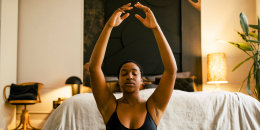We all know that sleep is important for overall health, but is one sleeping position better than another? The position you sleep in can affect your sleep duration, quality and much more.
Research shows that side-sleeping is the most common sleeping position among adults, followed by sleeping on the back, also called the “supine” position, according to the Sleep Foundation. Sleeping on the stomach is the least popular position.
Generally, people choose to sleep in whichever position is most comfortable and helps them feel rested, Shelby Harris, Psy.D., clinical psychologist and director of sleep health at Sleepopolis, previously told TODAY.com.
Other factors can also influence a person's preferred sleeping position, such as age, underlying health, body type, mattress firmness, and whether a person shares their bed with another person or a pet.
While sleeping on the side or back are generally considered safer and healthier than sleeping on the stomach, both have cons.
Ultimately, the healthiest sleeping position for you will depend on your individual preferences and needs. Certain positions may help or worsen underlying issues, from heartburn to snoring. Depending on the problem, one position may be better than the other.
Here's what to know about the benefits and downsides of sleeping on your side versus back, and which one may be healthiest for you.
Side-sleeping benefits and downsides
Sleeping on your side, either the left or right, is considered healthy and can have a number of benefits, the experts noted.
First, side-sleeping is the best position for breathing. "As sleep physicians, we often worry about snoring or sleep disordered breathing, such as sleep apnea,” Dr. Dianne Augelli, a sleep medicine specialist at Weill Cornell Medicine and New-York Presbyterian, previously told TODAY.com.
Side-sleeping can help keep the airways open, the experts explained, which may reduce snoring or help with sleep apnea.
Side-sleeping is also better for people with acid reflux. This occurs when acid from the stomach flows back up into the esophagus, which can cause heartburn, per the Cleveland Clinic.
Acid reflux often worsens at night, Augelli noted, and can disrupt sleep. Research suggests that sleeping on the left side in particular may help alleviate acid reflux symptoms during the night.
Sleeping on the side is also considered more safe and comfortable during pregnancy, Harris noted. It helps promote optimal blood flow and may lower the risk of certain complications, TODAY.com previously reported.
A downside of side-sleeping is that it can be difficult to keep the spine aligned, which can put pressure on the neck, back, or hips. Side-sleeping may exacerbate pain, especially in the neck or shoulders on the side you sleep on, the experts noted. If you fall asleep on one arm, this can reduce circulation or cause numbness.
Sleeping on one side with the face pressed into a pillow can also cause temporary lines or marks in the skin. While these "sleep lines" will go away, they can be a nuisance. Side-sleeping can also make it hard to keep your pillowcase clean due to the buildup of dead cells, oil and dirt from your face.
Pros of side-sleeping
- Better for breathing
- May help acid reflux
- Safer during pregnancy
Cons of side-sleeping
- Spinal misalignment
- Neck or shoulder pain
- Sleep lines
Back-sleeping benefits and downsides
Sleeping on the back is also considered healthy and is associated with various health benefits.
Back-sleeping is safe for most people, especially babies. The American Academy of Pediatrics recommends that infants be placed flat on their backs to sleep at night and during naps because it reduces the risk of sudden infant death syndrome (SIDS).
Sleeping flat on the back is also considered the best position to maintain spinal alignment, the experts noted. The supine position can help take pressure off the spine and joins, which may help alleviate back, neck and hip pain.
The right support can go a long way when sleeping on your back, said Augelli. Using pillows to support the head and neck, and smaller pillows under the lower back or knees, can also help keep the spine aligned and relaxed.
Back-sleeping may be beneficial for people with skin concerns — though, it's worth noting that getting enough sleep (no matter what position) is important for healthy skin. Sleeping in the supine position with the face upward can keep your nightly skin care on your face, not your pillow, and prevent sleep lines.
However, the supine position is considered one of the worst positions for breathing issues, snoring and sleep apnea.
When you sleep flat on your back, the force of gravity will pull more tissue (such as the tongue and soft palate) down into the airway, Augelli said. This can cause it to narrow and obstruct airflow. Some people only snore or experience sleep apnea while sleeping on their back, Augelli noted, which is called positional sleep apnea.
Sleeping flat on your back can also worsen acid reflux severity and frequency, because it makes it easier for stomach acid to flow up into the esophagus. Using pillows to prop up the head and elevate the upper body may help back alleviate heartburn.
Back-sleeping is not recommended during pregnancy, especially in the second and third trimesters, the experts noted. In the supine position, the weight of the growing fetus can put pressure on the spine and major blood vessels, per the American College of Obstetricians and Gynecologists.
Pros of back-sleeping
- Keeps spine aligned
- May help back and hip pain
- Safest for infants
- Better for skin
Cons of back-sleeping
- Breathing problems
- Acid reflux
- Unsafe in late pregnancy
Which is healthier, side- or back-sleeping?
If you're pregnant, or concerned about nighttime breathing and acid reflux, side-sleeping may be better for you.
If you're worried about spinal alignment, neck or back pain, or sleep lines, the supine position may be your best bet.
Ultimately, side-sleeping and sleeping flat on your back can both be healthy, the experts noted. And the best sleeping position for you is the one that is most comfortable, helps you fall and stay asleep, and wake up feeling rested with as little pain as possible.
“There’s no one best way to sleep,” Harris said.
Whichever position you sleep in, the goal should be the same: to get at least seven hours of sleep. Try to choose the right mattress and pillows to help you feel comfortable and supported.
Always talk to your doctor if you have concerns about your sleeping position, sleep quality or underlying health.










